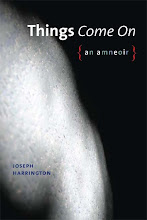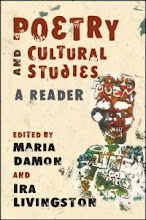I read a couple of books recently that take substantially different approaches to this business of telling history in poetry. And, once again, it has to do with how much narration there is and how much of the narration pertains to the past.
The books are The Inland Sea, by Brandon Shimoda (Tarpaulin Sky 2008) and from
To be fair, Perez’ book is 90+ pages, and Shimoda’s is less than half that – more of a chapbook. Right off the bat, here’s one of the problems: if you tell the story, you’re going to take up more pages. So one has to decide how much of the story is enough – and by what criteria. So Perez starts us off with a preface, in which we learn that “Guahan [Guam] has always been captured (and thus defined) for its strategic position in the Pacific (as a stopping post on the Spanish Galleon Trade Route, as a significant advancement for the Japanese Army during World War II, and as a continuing military colony of the U.S.).” The poet’s hope is that the island will emerge from these dominations “into further uprisings of meaning.” All of this orients one for the lyric poems that follow, not unlike Susan Howe’s miniature historical essays at the beginning of many of her books.
In the body of the text, we learn about the rebellion of Mata’pang, the terror of the Japanese occupation, and the ravages of the brown tree snake, as well as memories of Perez’ grandparents and the local culture they taught him. But most of the book is taken up with dispersed series of lyrics, interwoven with one another (not unlike Robert Duncan’s Passages, Uprisings, etc.). For instance, the first installment of “from Tidelands” goes:
“edge
closer to the illegible
borders - "let this cast open [hale']*
into razed “temporal fields andharness
“these tidal” palimpsests
* ed. note: this line is indented about eight spaces in the original. I still haven't figured this out.
Clearly the poem refers to the troubled history of Guahan – its insularity, vulnerability, the uprootedness of people and culture under the pressure of colonization [hale’ = root, in Chamoru], as well as the erasure and recovery of its history. If one saw the poem in an anthology (without a footnote), however, all of that would be, well, illegible. The lyrics function as both elegies and meditations on space (on the page, the ocean, etc.). But the history must be told – including with maps, diagrams and URLs. Though Perez lives on the mainland now, to do less would be to dishonor the memory of the people back home, living and dead.
One gets a very different vibe from
is it injurious to wear one’s self around one’s waist
in radiation first is flash
burn, second
flame
The poem “Crucian Carp” contains several such allusions to the bomb blasts and their aftermath. But at other points, there are snippets of narrative that are tossed out and left behind:
a single cloud holding
in the liquid
spilt
to my father
the afternoon after the morning of
the day he said that he liked men
or was it he said ‘boys’
emperor
unbinding from years of rigid fence
you felt not a thing for
Now, I can infer (or construct) a story from all this, and indeed, the form of it encourages me to do so. But much of it – most of it – is elided, redacted, unspoken. Clearly, that’s part of the point. But what does that do to the past? The people – mere characters – where are the ethical edges? I’m not saying I know. But I do think the book succeeds without the gestures toward biography and specific histories:
away
blanched
branches
reach by yonder fast
the reeds of the paradise boat
In any event, both are very good books that speak to the difficulty of telling history (and the problems with information) and feeling it at the same time. I sure haven’t figured it out!










